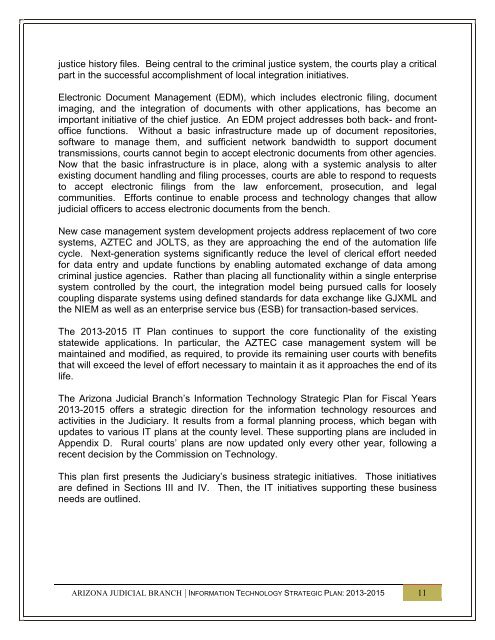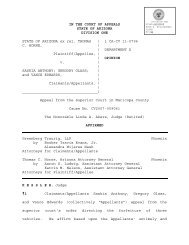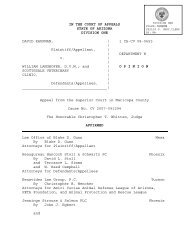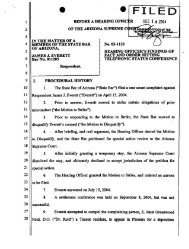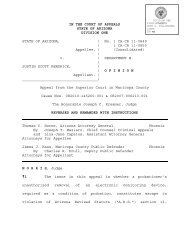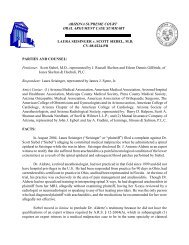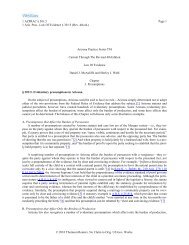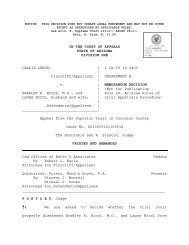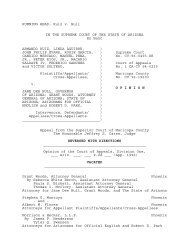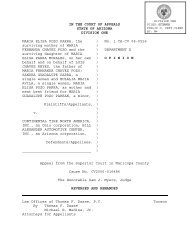Print Version - Arizona Judicial Department
Print Version - Arizona Judicial Department
Print Version - Arizona Judicial Department
Create successful ePaper yourself
Turn your PDF publications into a flip-book with our unique Google optimized e-Paper software.
justice history files. Being central to the criminal justice system, the courts play a critical<br />
part in the successful accomplishment of local integration initiatives.<br />
Electronic Document Management (EDM), which includes electronic filing, document<br />
imaging, and the integration of documents with other applications, has become an<br />
important initiative of the chief justice. An EDM project addresses both back- and frontoffice<br />
functions. Without a basic infrastructure made up of document repositories,<br />
software to manage them, and sufficient network bandwidth to support document<br />
transmissions, courts cannot begin to accept electronic documents from other agencies.<br />
Now that the basic infrastructure is in place, along with a systemic analysis to alter<br />
existing document handling and filing processes, courts are able to respond to requests<br />
to accept electronic filings from the law enforcement, prosecution, and legal<br />
communities. Efforts continue to enable process and technology changes that allow<br />
judicial officers to access electronic documents from the bench.<br />
New case management system development projects address replacement of two core<br />
systems, AZTEC and JOLTS, as they are approaching the end of the automation life<br />
cycle. Next-generation systems significantly reduce the level of clerical effort needed<br />
for data entry and update functions by enabling automated exchange of data among<br />
criminal justice agencies. Rather than placing all functionality within a single enterprise<br />
system controlled by the court, the integration model being pursued calls for loosely<br />
coupling disparate systems using defined standards for data exchange like GJXML and<br />
the NIEM as well as an enterprise service bus (ESB) for transaction-based services.<br />
The 2013-2015 IT Plan continues to support the core functionality of the existing<br />
statewide applications. In particular, the AZTEC case management system will be<br />
maintained and modified, as required, to provide its remaining user courts with benefits<br />
that will exceed the level of effort necessary to maintain it as it approaches the end of its<br />
life.<br />
The <strong>Arizona</strong> <strong>Judicial</strong> Branch’s Information Technology Strategic Plan for Fiscal Years<br />
2013-2015 offers a strategic direction for the information technology resources and<br />
activities in the Judiciary. It results from a formal planning process, which began with<br />
updates to various IT plans at the county level. These supporting plans are included in<br />
Appendix D. Rural courts’ plans are now updated only every other year, following a<br />
recent decision by the Commission on Technology.<br />
This plan first presents the Judiciary’s business strategic initiatives. Those initiatives<br />
are defined in Sections III and IV. Then, the IT initiatives supporting these business<br />
needs are outlined.<br />
ARIZONA JUDICIAL BRANCH | INFORMATION TECHNOLOGY STRATEGIC PLAN: 2013-2015 11


